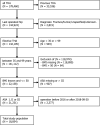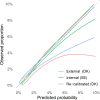Prediction of Early Periprosthetic Joint Infection After Total Hip Arthroplasty
- PMID: 35281208
- PMCID: PMC8904265
- DOI: 10.2147/CLEP.S347968
Prediction of Early Periprosthetic Joint Infection After Total Hip Arthroplasty
Abstract
Purpose: To develop a parsimonious risk prediction model for periprosthetic joint infection (PJI) within 90 days after total hip arthroplasty (THA).
Patients and methods: We used logistic LASSO regression with bootstrap ranking to develop a risk prediction model for PJI within 90 days based on a Swedish cohort of 88,830 patients with elective THA 2008-2015. The model was externally validated on a Danish cohort with 18,854 patients.
Results: Incidence of PJI was 2.45% in Sweden and 2.17% in Denmark. A model with the underlying diagnosis for THA, body mass index (BMI), American Society for Anesthesiologists (ASA) class, sex, age, and the presence of five defined comorbidities had an area under the curve (AUC) of 0.68 (95% CI: 0.66 to 0.69) in Sweden and 0.66 (95% CI: 0.64 to 0.69) in Denmark. This was superior to traditional models based on ASA class, Charlson, Elixhauser, or the Rx Risk V comorbidity indices. Internal calibration was good for predicted probabilities up to 10%.
Conclusion: A new PJI prediction model based on easily accessible data available before THA was developed and externally validated. The model had superior discriminatory ability compared to ASA class alone or more complex comorbidity indices and had good calibration. We provide a web-based calculator (https://erikbulow.shinyapps.io/thamortpred/) to facilitate shared decision making by patients and surgeons.
Keywords: clinical decision-making tool; external validation; orthopaedics; prediction model; total hip arthroplasty; web calculator.
© 2022 Bülow et al.
Conflict of interest statement
OR is a principal investigator for research partly founded by Pfizer; OR is a register director of the Swedish Arthroplasty Register (SAR) and board member of the International Society of Arthroplasty Registries. NPH has received institutional support from Waldemar Link GmbH, and Zimmer Biomet; also reports personal fees from Heraeus Medical, Germany. NPH is president of the Nordic Arthroplasty Register Association, member of the steering committee of SAR, and Co-Editor of Acta Orthopaedica; no other relationships or activities that could appear to have influenced the submitted work. The authors report no other conflicts of interest in this work.
Figures







Similar articles
-
Prediction of 90-day mortality after total hip arthroplasty.Bone Joint J. 2021 Mar;103-B(3):469-478. doi: 10.1302/0301-620X.103B3.BJJ-2020-1249.R1. Bone Joint J. 2021. PMID: 33641419
-
The ACS NSQIP Risk Calculator Is a Fair Predictor of Acute Periprosthetic Joint Infection.Clin Orthop Relat Res. 2016 Jul;474(7):1643-8. doi: 10.1007/s11999-016-4717-3. Clin Orthop Relat Res. 2016. PMID: 26911971 Free PMC article.
-
Periprosthetic Joint Infection in Hip Arthroplasty: Is There an Association Between Infection and Bearing Surface Type?Clin Orthop Relat Res. 2016 Oct;474(10):2213-8. doi: 10.1007/s11999-016-4916-y. Clin Orthop Relat Res. 2016. PMID: 27249955 Free PMC article.
-
The association between socioeconomic status and the 30- and 90-day risk of infection after total hip arthroplasty : a registry-based cohort study of 103,901 patients with osteoarthritis.Bone Joint J. 2022 Feb;104-B(2):221-226. doi: 10.1302/0301-620X.104B2.BJJ-2021-1030.R1. Bone Joint J. 2022. PMID: 35094583
-
Estimating risk in Medicare patients with THA: an electronic risk calculator for periprosthetic joint infection and mortality.Clin Orthop Relat Res. 2013 Feb;471(2):574-83. doi: 10.1007/s11999-012-2605-z. Epub 2012 Nov 21. Clin Orthop Relat Res. 2013. PMID: 23179112 Free PMC article.
Cited by
-
Data-Driven Approach to Development of a Risk Score for Periprosthetic Joint Infections in Total Joint Arthroplasty Using Electronic Health Records.J Arthroplasty. 2025 May;40(5):1308-1316.e13. doi: 10.1016/j.arth.2024.10.129. Epub 2024 Nov 1. J Arthroplasty. 2025. PMID: 39489386
-
Cutibacterium acnes in confirmed and probable deep shoulder infections.Shoulder Elbow. 2025 Jul 17:17585732251359946. doi: 10.1177/17585732251359946. Online ahead of print. Shoulder Elbow. 2025. PMID: 40689355 Free PMC article.
-
Preoperative dental screening can reduce periprosthetic infections of hip and knee endoprostheses in the first month after surgery: results of a cohort study.Infection. 2024 Apr;52(2):535-543. doi: 10.1007/s15010-023-02128-2. Epub 2023 Dec 7. Infection. 2024. PMID: 38060067 Free PMC article.
-
Preoperative Risk Factor Analysis and Dynamic Online Nomogram Development for Early Infections Following Primary Hip Arthroplasty in Geriatric Patients with Hip Fracture.Clin Interv Aging. 2022 Dec 21;17:1873-1883. doi: 10.2147/CIA.S392393. eCollection 2022. Clin Interv Aging. 2022. PMID: 36575659 Free PMC article.
-
Risk equations for prosthetic joint infections (PJIs) in UK: a retrospective study using the Clinical Practice Research Datalink (CPRD) AURUM and GOLD databases.BMJ Open. 2024 May 7;14(5):e082501. doi: 10.1136/bmjopen-2023-082501. BMJ Open. 2024. PMID: 38719289 Free PMC article.
References
-
- Shohat N, Bauer T, Buttaro M, et al. Hip and knee section, what is the definition of a Periprosthetic Joint Infection (PJI) of the knee and the hip? Can the same criteria be used for both joints?: proceedings of international consensus on orthopedic infections. J Arthroplasty. 2019;34(2):S325–S327. doi:10.1016/j.arth.2018.09.045 - DOI - PubMed
-
- Malizos KN, Kirketerp-Møller K. Incidence and socioeconomic impact of Bone and Joint Infections (BJIs): the European perspective. In: Kendoff D, Morgan-Jones R, Haddad FS, editors. Periprosthetic Joint Infections: Changing Paradigms. Cham: Springer International Publishing; 2016:3–18. doi:10.1007/978-3-319-30091-7_1 - DOI
LinkOut - more resources
Full Text Sources

